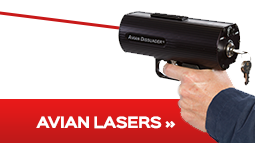LP Gas Cannons and the Scare Wars® System
The use of LP gas cannons to supplement bird and wildlife control efforts in an integrated program can be a very effective mitigation strategy if used properly. While all other standard measures such as habitat management, exclusionary structures, and use of other frightening devices such as pyrotechnics, are needed in an integrated approach, LP gas cannons can be employed as part of an overall program to bolster results. Such systems employ pressurized liquid propane (LP) gas detonated in a controlled manner from cannons strategically placed to deter birds and wildlife from areas where they are not welcome. They are commonly used in agriculture, on landfills, on airports, and in other applications. As with any other method, these are not silver bullets to be used indiscriminately if success is to be achieved. Many a wildlife control specialist or other user has purchased gas cannons and then complained that they failed to produce expected results. In virtually every case, it is because they were improperly employed and not the fault of the system or concept itself.
Propane cannon systems require a detonation chamber, triggering mechanism, propane tank, and supporting structures. Newer models are assisted by external power supplies such as batteries and solar panels. To be most effective, all of this equipment must be moved on a frequent basis to avoid habituation from birds or other wildlife to be dispersed. Equipment can be placed on a sled, cart, or other mobile system to facilitate easy movement to new locations. Cannons mounted on rotating platforms which enable detonations to be redirected with each cycle can delay, but not prevent habituation. Cannons passively operated on timing mechanisms that produce regular or even random detonations and simply left in place are doomed to fail. Birds and other wildlife may not be in the immediate vicinity and will become accustomed to the sounds and learn to approach without consequence.
A significant issue with timers for detonation sequences in some scenarios, especially at airports, is that there is no way to control when the wildlife might react and could actually place them in a more hazardous situation than if used discriminately by an operator. Therefore, in applications such as aviation, cannons should only be triggered when birds or wildlife are actually in the immediate range of the cannons and at times when wildlife can safely be dispersed. Remotely triggered operation by personnel is the only way to effectively achieve this.
An excellent design to overcome the issues described above is the Scare Wars® system. Airports are the most common users of the system, and application of the system can be very effective at minimizing potential aviation safety risks. The Scare Wars® system uses a series of cannons that can be placed through or around an area where birds must be deterred, such as surrounding runways or air operations areas. The real advantages of the system are achieved through the digital remote control programs that are operated by personnel such as wildlife mitigation specialists, airport operations, or air traffic controllers through wireless interfaces with remote triggering devices. The user can select individual cannon, a group, a series, or any combination of these to selectively detonate only when birds or wildlife are present and timed to achieve results.
The Scare Wars® system can be further customized with the integrated use of species-specific distress or alarm calls of birds to be dispersed. The distress cries are activated by the system when necessary to supplement cannon detonations. Location of each individual unit within the system can also be customized to provide maximum effect and visibility for the remote operator.
Integrated properly within a comprehensive wildlife mitigation program, the Scare Wars® system can be an invaluable resource for reducing bird and wildlife damage, economic losses, and health and safety risks.







